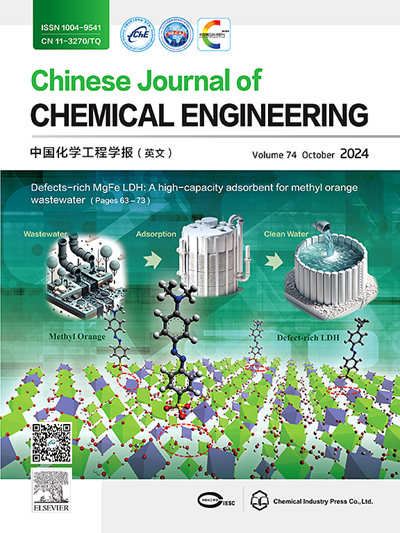通过增强表面相互作用原位合成混价锰oxide@S, P自共掺杂carbon@reduced氧化石墨烯复合材料的高性能全固态超级电容器
IF 3.7
3区 工程技术
Q2 ENGINEERING, CHEMICAL
引用次数: 0
摘要
通过增强金属氧化物颗粒与碳基材料的表面相互作用,可以有效地提高法拉第电容和电导率,最终在超级电容器中实现高能量密度和充分的氧化还原反应。通过温和的生物矿化工艺和随后的热还原策略,我们成功地制备了氧化石墨烯(GO)包裹混合价锰氧化物(MnOx)和S, P自共掺杂碳基多孔复合材料(MnOx@SPC@还原氧化石墨烯(RGO))。在工程假单胞菌(Pseudomonas sp., M1)细胞的生物矿化过程中,氧化石墨烯纳米片作为“土壤”吸附Mn2+离子并均匀分散生物源性锰氧化物(BMO)。经过退火后,MnOx纳米颗粒被石墨烯均匀包裹,从而产生MnOx@SPC@RGO3复合材料。该复合材料具有强的C-O-Mn键界面,大量的电活性位点和均匀的孔隙结构。通过优化高导电性石墨烯与MnOx表面电容之间的协同作用,MnOx@SPC@RGO3电极具有Mn2+ + Mn3+和Mn3+ + + + + +的插层法拉第反应机制,具有优异的比容量(在0.5 A·g−1时为448.3 F·g−1)、乘法性能(在10 A·g−1时为340.5 F·g−1)和循环稳定性(循环5000次后保持率为93.8%)。此外,MnOx@SPC@RGO3//PC的非对称全固态超级电容器具有64.8 W·h·kg - 1的能量密度和350 W kg - 1的功率密度,并且在10000次循环后具有92.5%的电容保持率。总之,利用生物矿化和热还原的合成路线在开发全固态超级电容器应用的高性能电极材料方面具有巨大的潜力。本文章由计算机程序翻译,如有差异,请以英文原文为准。

In-situ synthesis of mixed-valence manganese oxide@S, P self-codoped carbon@reduced graphene oxide composites by enhanced surface interaction for high-performance all-solid-state supercapacitors
By enhancing surface interaction between metal oxide particles and carbon-based materials, it can effectively improve Faraday capacitance and conductivity, ultimately achieving high energy density with sufficient redox reactions in supercapacitors. Through a gentle biomineralization process and subsequent thermal reduction strategy, we successfully prepared the graphene oxide (GO) wrapping mixed-valence manganese oxides (MnOx) and S, P self-codoped carbon matrix porous composite (MnOx@SPC@reduced graphene oxide (RGO)). During the biomineralization process of engineered Pseudomonas sp. (M1) cells, GO nanosheets functioned as the ‘soil’ to adsorb Mn2+ ion and uniformly disperse biogenic Mn oxides (BMO). After undergoing annealing, the MnOx nanoparticles were evenly wrapped with graphene, resulting in the creation of the MnOx@SPC@RGO3 composite. This composite possesses strong C—O—Mn bond interfaces, numerous electroactive sites, and a uniform pore structure. By optimizing the synergistic interaction between the highly conductive graphene and the remarkable surface capacitance of MnOx, the MnOx@SPC@RGO3 electrode, with its intercalation Faraday reactions mechanism of Mn2+ ⇌ Mn3+ and Mn3+ ⇌ Mn4+ transformations, exhibits an outstanding specific capacity (448.3 F·g−1 at 0.5 A·g−1), multiplying performance (340.5 F·g−1 at 10 A·g−1), and cycling stability (93.8% retention after 5000 cycles). Moreover, the asymmetric all-solid-state supercapacitors of MnOx@SPC@RGO3//PC exhibit an exceptional energy density of 64.8 W·h·kg−1 and power density of 350 W kg−1, as well as a long lifespan with capacitance retention of 92.5% after 10000 cycles. In conclusion, the synthetic route utilizing biomineralization and thermal reduction exhibits significant potential for exploiting high-performance electrode materials in all-solid-state supercapacitor applications.
求助全文
通过发布文献求助,成功后即可免费获取论文全文。
去求助
来源期刊

Chinese Journal of Chemical Engineering
工程技术-工程:化工
CiteScore
6.60
自引率
5.30%
发文量
4309
审稿时长
31 days
期刊介绍:
The Chinese Journal of Chemical Engineering (Monthly, started in 1982) is the official journal of the Chemical Industry and Engineering Society of China and published by the Chemical Industry Press Co. Ltd. The aim of the journal is to develop the international exchange of scientific and technical information in the field of chemical engineering. It publishes original research papers that cover the major advancements and achievements in chemical engineering in China as well as some articles from overseas contributors.
The topics of journal include chemical engineering, chemical technology, biochemical engineering, energy and environmental engineering and other relevant fields. Papers are published on the basis of their relevance to theoretical research, practical application or potential uses in the industry as Research Papers, Communications, Reviews and Perspectives. Prominent domestic and overseas chemical experts and scholars have been invited to form an International Advisory Board and the Editorial Committee. It enjoys recognition among Chinese academia and industry as a reliable source of information of what is going on in chemical engineering research, both domestic and abroad.
 求助内容:
求助内容: 应助结果提醒方式:
应助结果提醒方式:


